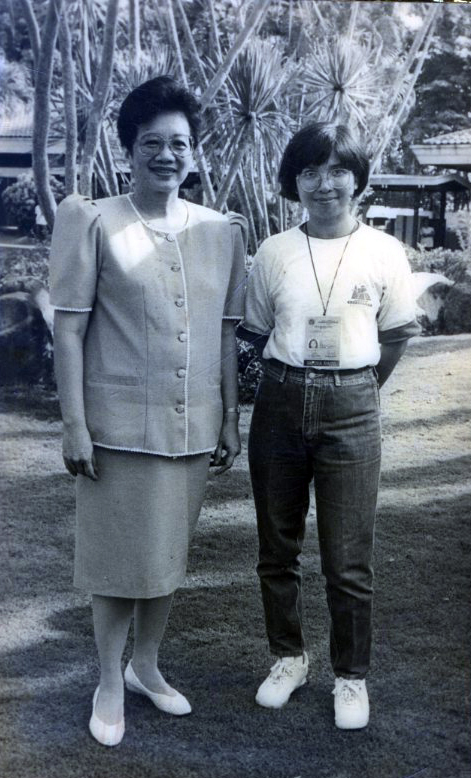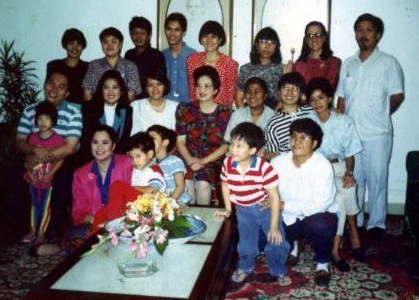By CHIT ESTELLA
FOR someone who had undergone much sorrow and pain, Corazon Aquino laughed easily and well.
People unaccustomed to hearing the former president laugh would quickly turn around to look for the source of the guffaw and be surprised at the woman who was known to be demure and self-effacing. But she was given to hearty laughter, especially when faced with the ridiculous or simply anything hilarious. On one of those occasions, she was sorely misunderstood.
I was one of the reporters covering Malacanang in the last half of Mrs. Aquino’s six-year term as president. I was working for the daily newspaper Malaya. It was a time when the Philippines became, for some reason, a frequent disaster zone. One calamity kept happening after another–typhoons kept hitting the country and a volcano that lay dormant for 600 years suddenly erupted and put a large area of Luzon under cover of darkness and a thick layer of lahar. Countries and international organizations that rushed eagerly to help the country at the beginning of Mrs. Aquino’s presidency began complaining and said they were suffering from what their representatives called “donor fatigue.”
One day, while waiting at the gazebo for Cabinet officials to come out of the Guest House which served as the President’s office, the ground literally started shaking beneath our feet. Water from the Pasig River began splashing onto the Palace grounds. To keep from falling down, reporters had to hold on to one another for support. Then came the frightening realization: Earthquake!
 But it was over in a couple of minutes and the reporters wondered what the intensity was. Then, Malacanang officials started coming out of the Guest House, President Aquino among them. As they gathered outside, one official recounted how they all scampered under the table when the tremors became too strong to be ignored. They never saw one another in such awkward positions! Everyone laughed but Mrs. Aquino laughed the hardest.
But it was over in a couple of minutes and the reporters wondered what the intensity was. Then, Malacanang officials started coming out of the Guest House, President Aquino among them. As they gathered outside, one official recounted how they all scampered under the table when the tremors became too strong to be ignored. They never saw one another in such awkward positions! Everyone laughed but Mrs. Aquino laughed the hardest.
Seen on television news that night, after stories of fatalities began coming in from the provinces, the laughter scene in Malacanang reaped criticisms from those who saw it. Viewers were shocked by what they thought was the President’s insensitivity. She had to explain that stories of the tragedies had not yet reached her by then. Even so, she quickly apologized to the public.
That was one thing about Mrs. Aquino: She had no problems with making an apology. And she did this as soon as the offense–real or imagined–was pointed out. In one other occasion, it was Manila Archbishop Jaime Cardinal Sin who publicly scolded Mrs. Aquino and her vice president, the late Salvador H. Laurel, for their political bickerings. Right then and there, the President apologized to the nation. Filipinos had no problem believing she was truly sorry either.
Credibility was something that Mrs. Aquino enjoyed with media. She never surprised us by turning around on any issue to which she had already given her position. When she was undecided, she would say so. When she didn’t like a question, she’d let us know. Reporters at the early part of her term said she’d smile whenever she refused to answer a question. Later in her term, she would still smile on those occasions but she had also realized her prerogative to show irritation.
She didn’t hide her emotions. She’d raise her eyebrows when delighted, frown when she didn’t understand or welcome a question, and roll her eyes when exasperated. And because she usually gave short answers, even her facial expressions would find their way to our stories.
Perhaps the demands of the presidency became heavier as she moved on to the completion of her term. Increasingly, she realized that she could choose what to do when she wanted to. Meetings with the press became less frequent and statements from her spokesman or press secretary came more often. Journalists were not happy with that, especially when ambush interviews became more difficult with security restrictions. The dynamics between the President and the press continued in a relentless tug-of-war that would end with a compromise in some form.
Still, Mrs. Aquino’s relationship with the press remained strong and warm. In one of her birthdays, the press corps gifted her with a dress, a brown and blue number that a designer agreed to do after some haggling by the reporters. Within a few days after receiving this, the President wore it. (I do not remember, however, if she wore it again.)
At other times, the Palace reporters were at the receiving end of the President’s generosity. One afternoon, a bowl of pate arrived at the press office. Immediately buying some pan de sal, the reporters helped themselves to the best merienda they ever had. We were later told that Mrs. Aquino–who knows her way in the kitchen quite well–made the pate herself.
She was not above playing the role of host to media. Near the close of her term, she treated the press to a tour of Hacienda Luisita, the vast Cojuangco-owned sugar plantation that covered 11 barangays and escaped land reform. Reporters were too awed to ask about the possibility of land distribution among the sugar workers.
We learned the rhythm and work habits of the President quite early. It became clear that she preferred working regular hours, from 8 a.m. to 5 p.m. There were certain events and meetings held beyond that time but these were the exceptions rather than the rule.
Mondays to Fridays were her working days and that presented quite a problem for media that needed to put out stories every day. Saturdays were spent by the President taping her program, “Magtanong sa Pangulo.” The transcript would be made available the following day, Sunday, to the press. On the basis of the discussions in that transcript, reporters would write their stories.
Stories from “Magtanong…” were rarely exciting but the dialogues that the President had with ordinary Filipinos in that program were real. Indeed, serious governance was harder to write about.
Much easier to report were the foreign trips that Mrs. Aquino made. In France, she was hailed as a modern-day Joan of Arc or the political equivalent of the celebrated singer Edith Piaf. In the United States where she spoke before a joint session of Congress, American legislators did not mind looking silly while wearing miniature Cory dolls on their lapels. Everyone wanted to shake the hand of the diminutive Philippine leader who spoke so well and so touchingly that the late Washington Post publisher Katharine Graham wondered if it was actually an American who had written her speech. Even the Kennedys jumped in on the bandwagon by hosting an event graced by Cory Aquino.
But back home, the luster of Edsa was fading quickly. In the last few years of Mrs. Aquino’s term, celebrations had become less festive and the malaise brought about by cynicism was beginning to be felt. Ironically, the government had become more stable. Gone were the days when reporters would warily walk inside the Palace grounds that have just been bombed that morning by rebel soldiers. The enemy was no longer the defeated mutineers but the victorious beneficiaries of People Power.
But Mrs. Aquino knew that. She would be the last to say that the work was over. Never known to mince words or disguise their meaning, she made it known in her last State of the Nation Address that she was going to continue serving her country. No longer as president but as a private citizen. And the public and the press believed her.
